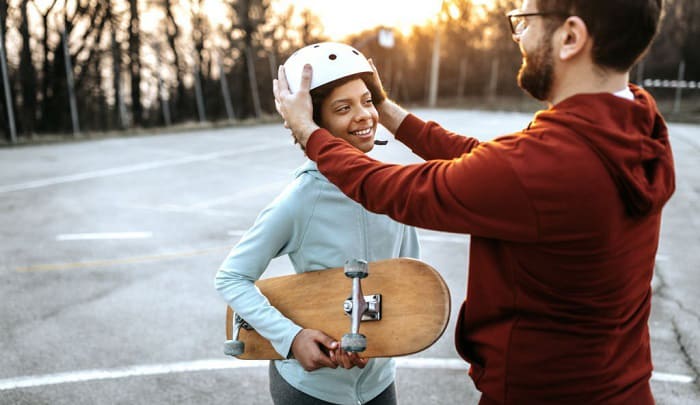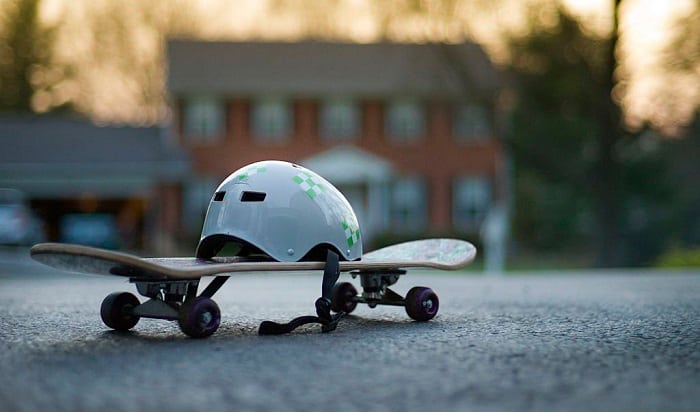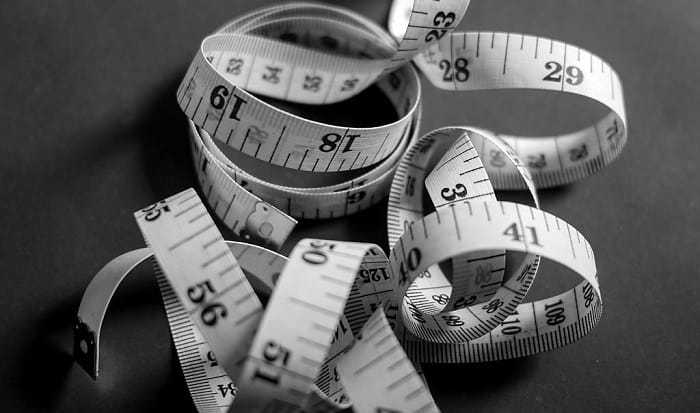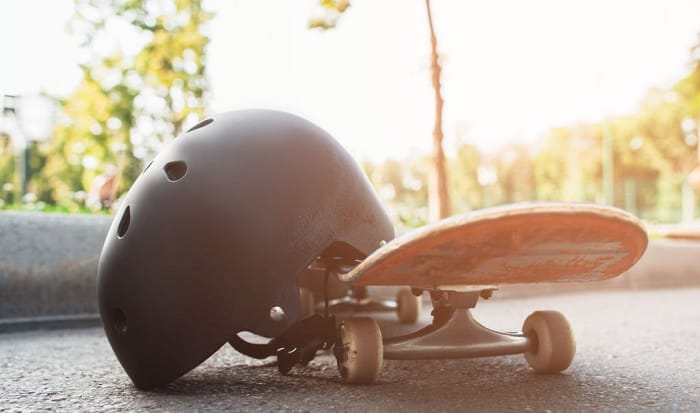Every skateboarder, pro or beginner, knows the need for safety in the sport. This aspect includes the proper execution of tricks and stunts and having protective measures such as wearing skateboard gear.
Of these pieces of safety equipment, the helmet plays the most crucial role because of our head’s sensitivity. And if you’re about to purchase this item for the first time, one of the things you need to ask would be, “how should a skateboard helmet fit?”
Ideally, helmets should fit snugly, and this is only possible given the right balance of relevant factors.
Table of Contents
The Perfect Skate Helmet Fit
If you have ever come across more than a pair of skate helmets and pads, you might now be able to distinguish how one fits versus the other. But for purposes of better discussion, let me illustrate three tightness levels of a skateboard helmet.
1. Tight
Anything worn tightly and without reference to a size guide can be painful and uncomfortable.
When do we know a skate helmet is tight? One of the things we can do is compare our head’s dimensions versus that of the helmet. If you’re sure about the latter numbers, you might not need to fit the helmet on your head yet.
However, if you feel uncertain about these figures, it’s time to wear the headgear. As soon as you put that skateboard helmet on your head, start assessing its tightness. If it imposes too much pressure on any area of your head, it’s not the best helmet for you.
2. Loose
Too much space between the helmet’s padding and your head’s surface is another thing you should avoid. There is a risk that the helmet could fall off and make you vulnerable once you have an accident with your skateboard.
While the straps greatly help secure the helmet below your chin, the chances of the headgear sliding elsewhere are still high.
The best way to know if your helmet’s loose is by moving your head forward and backward. If the gear slips off, it’s big and is not the perfect size for you.
3. Snug fit
Neither of the instances as mentioned above defines the ideal helmet fit on a skateboarder.
Wearing a skateboard helmet should yield a snug fit. It shouldn’t come too tight or too loose. Achieving this fit can be challenging for some, but here are a few green flags to watch out for:
- The helmet rim should align with your eyebrows. It should not be too far away from them.
- You should retain full vision as if you’re not wearing any headgear.
- The side straps make a V-shape in front of your ears.
- No space beyond the equivalent of 1 to 2 fingers should sit between the chin and the strap. A simple test to this is the ease of yawning.
- With all straps fastened, the helmet should remain stable and not move.
Skateboard Helmet Adjustment Features
Human heads can differ in form, which means helmets for skateboarding may not fit people right away. And if you happen to encounter this challenge, don’t worry because several brands have come up with these innovations to help you.
1. Straps
The straps are the pieces of nylon rope that dangle from the upper ear’s side of the helmet. These parts run down to wrap around your chin.
On their ends is a chin protector, and a specialized helmet fastener. This part may come in an elastic material with padding to protect the rider. Some brands also have their respective takes on this, but their mechanism does not differ that much.
Looking at these helmet accessories, you’ll see that they come with loops and adjusters designed to help you manage the tightness of the helmet. And they can be fragile, so be careful working with them.
2. Adjustment dial
I often see this feature with helmets for young skaters. Adjustment dials are at the back of the helmet and can be rotated to loosen or tighten the fit.
3. Paddings
At first, I thought the cushion layers inside the helmet were for sweat absorption and added comfort only. But that was until I got to wear a well-padded brand.
Helmets often come with two paddings, with one being removable. And I think it’s the detachable layer that helps the helmet achieve a snug fit on the head. Not only that, but it also helps absorb impact.
Head Measurement for Skateboard Helmets
You need to measure a specific head area to identify the perfect skateboard helmet sizes. Here’s how to do it.
Step 1: Get a measuring tool.
Ideally, the best tool to use is a tailor’s measuring tape. If you can’t seem to find one, you can use a non-stretchable rope and a ruler to get the exact figures.
Step 2: Measure your head’s diameter.
With your measuring tool, plot one end above your eyebrows. Route the other end to the back of your head and above your ears. Finally, tighten the tape around your head and mark the part reaching the tape’s end.
Note that the tape should be a snug fit. It should be indicative of the perfect tightness you want with your helmet.
Step 3: Note and match your numbers.
After securing your head’s circumference, it’s time you go to a skate equipment store. Present your numbers to the store attendant and ask for the ideal size chart and options.
Then, you can try fitting one helmet after another and decide which one suits you best.
Skateboard Helmet Options
Whether searching for a men’s or women’s skateboard helmet, there will always be top-emerging brands and models for this headgear. Here are a few of them.
1. Triple 8 Helmet
Having this brand’s headgear gives the rider a heightened level of confidence. Most Triple 8 helmets come with certifications from trusted bodies, making them a safe go-to brand.
This helmet brand also has premium cushioning, and many skaters with helmets love it because of its comfort.
2. OutdoorMaster Skating Helmet
This helmet brand is more of a more versatile one. Besides working well for skating, OutdoorMaster helmets also suit bikers. Not only that, but this brand comes with various color options to match the aesthetic preferences of any skateboarder.
3. Pro Tec Helmet
Pro-Tec helmets are famous for their value and ventilation. For example, its Classic Helmet variant has 11 vent holes, sufficient to keep your head dry and comfortable during rides.
On another note, the headgear of this brand is also worth its price. These products are not the cheapest, but they meet the minimum requirements of a well-ventilated, comfortable, and durable skateboarding helmet.
Conclusion
There’s no better feeling than wearing skate gear of your size. It doesn’t only make you feel comfortable but also lets you become more confident.
Especially with safety equipment like helmets, we can’t disregard numbers. Otherwise, we’ll end up compromising our health.
So, how should a skateboard helmet fit? It should wrap your head snugly and in no way feel too tight or loose. And now that you know how to measure and match your head’s size with the helmet, you can finally land on the best headgear for yourself.

Hi, I am Charles Harris. I opened this site to write as much as I can about my biggest passion – skateboarding!
I started as a clumsy yet passionate rookie 10 years ago to now a still passionate yet much better skateboarder! But I have to tell you, the whole journey has always been fun and rewarding, indeed not without hardship.






